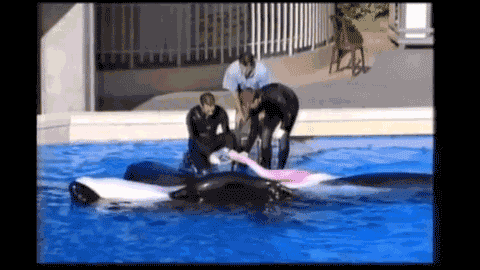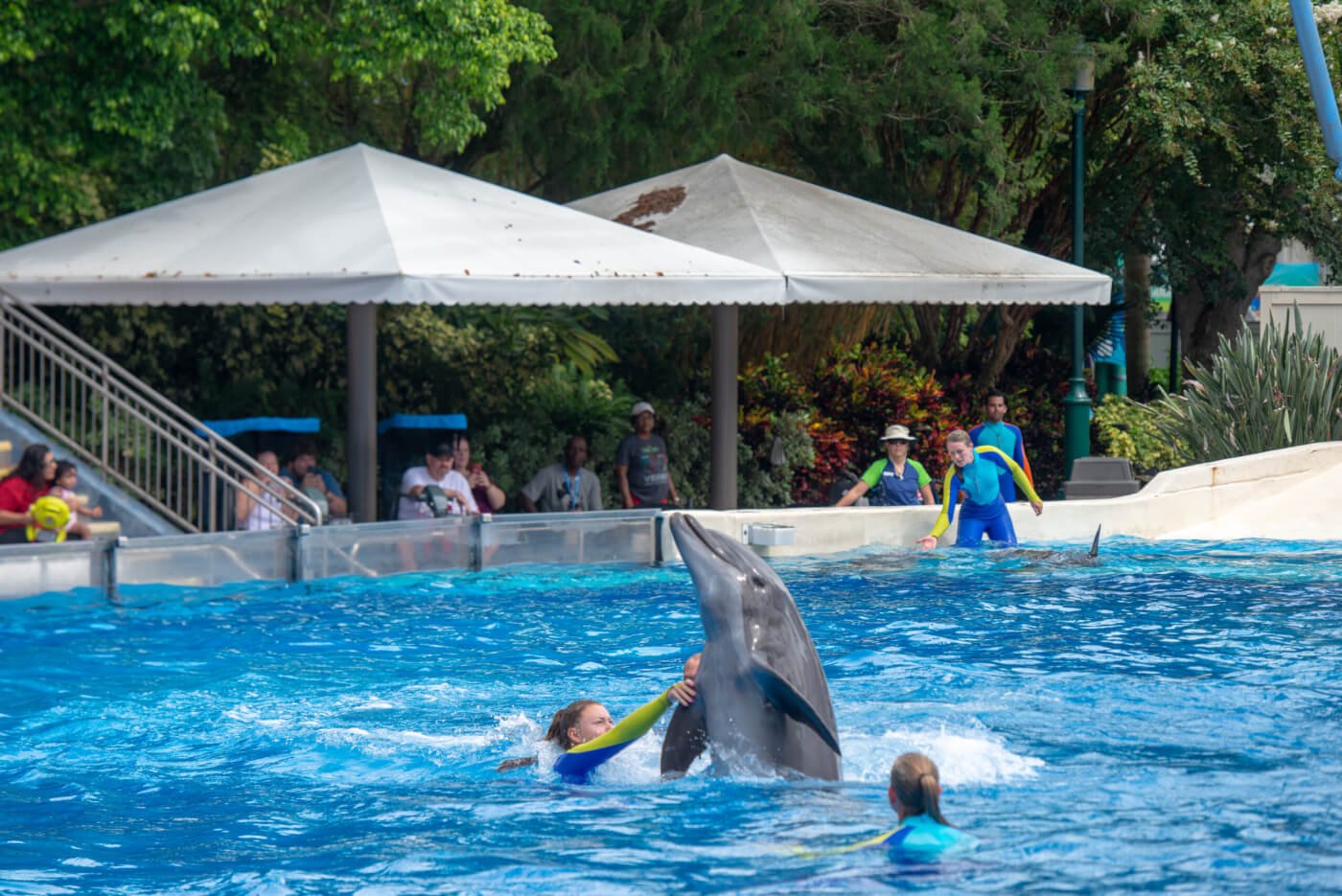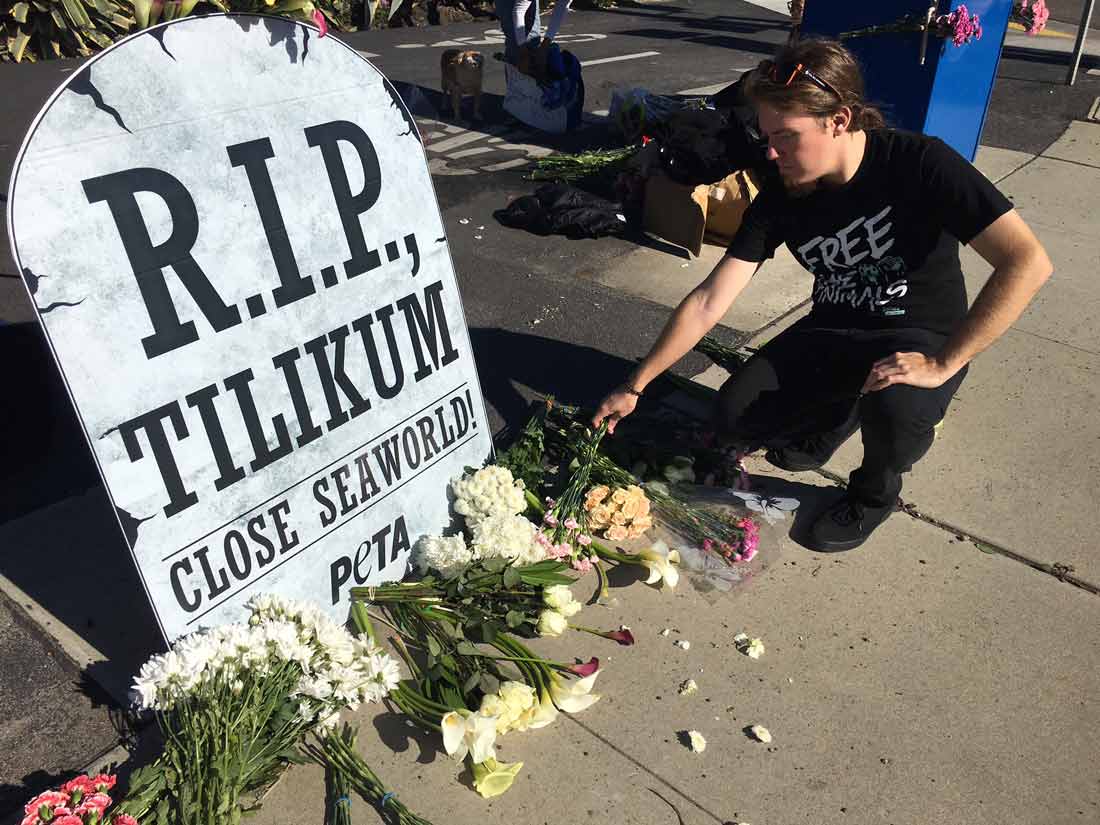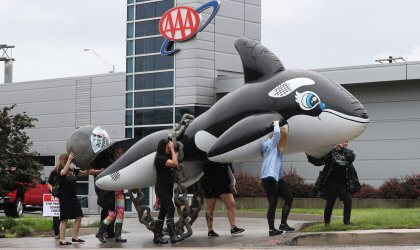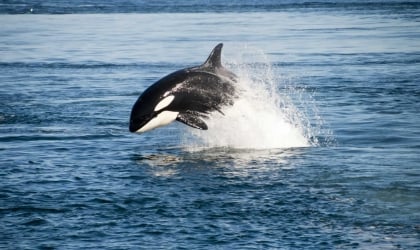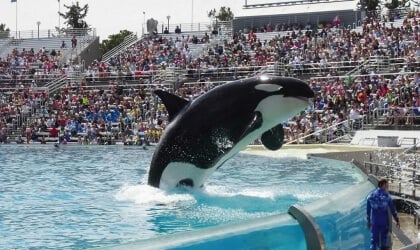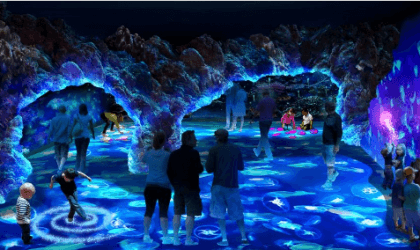In many cases, a 50th anniversary is cause for celebration. For Corky the orca, however, five decades of captivity is no reason to party.
On December 11, 1969, she was violently captured off the coast of British Columbia.
This means that Corky, who’s spent her last 50 years in a concrete tank, has been imprisoned longer than any other wild-caught orca. After she was forcibly separated from her pod, she was sold into captivity. Today, she’s held in one of SeaWorld San Diego’s cramped tanks, with little to do but swim in endless circles.
To reflect on the 50 years that Corky has spent as a prisoner, we’re listing 50 of the most awful things that have taken place (some of which are still going on) at SeaWorld since her 1969 abduction. Find out which atrocities made the list:
- When SeaWorld was still buying orcas who were taken from their families, the company’s orca hunter hired divers to cut open the stomachs of five orcas, fill them with rocks, and put anchors around the animals’ tails in order to sink them to the bottom of the ocean so that their deaths wouldn’t be discovered.
- Between 1970 and 1971, 10 orcas were captured from their ocean homes in Puget Sound. Half of them were sent to SeaWorld, and all five died prematurely.
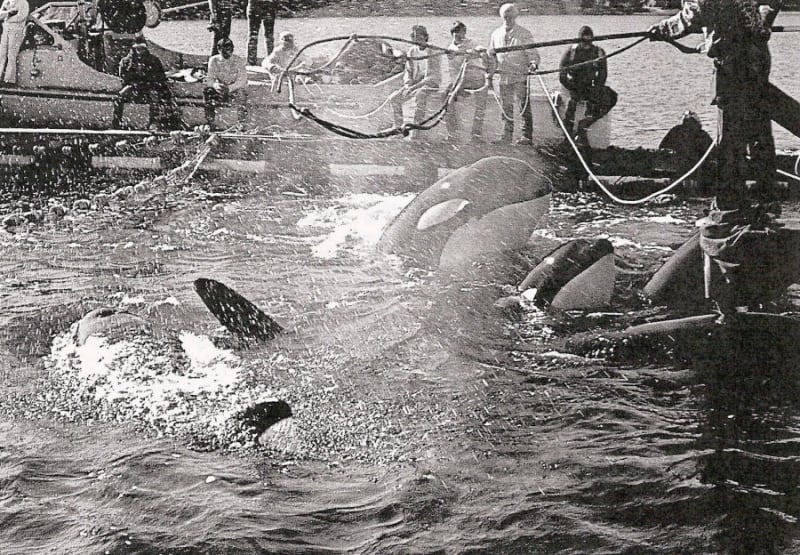 © Terrell C. Newby, Ph.D.
© Terrell C. Newby, Ph.D.- In 1978, SeaWorld captured two sharks in the ocean and put them in an enclosure. Within three days, they’d run into a wall, sunk to the bottom of the enclosure, and died.
- Despite the tragedy described above, SeaWorld continues to imprison and kill different species of sharks.
- In 1983, 12 dolphins were captured in their home waters of Chile to be put on display at SeaWorld. Half of them died within six months.
- SeaWorld staff covered up orca sunburns with black zinc oxide.
- SeaWorld trainers masturbated male orcas to collect sperm. The marine park company still does this to other dolphins today.
- A trainer died following a 2010 attack by an orca at SeaWorld San Diego.
- On January 11, 2012, the U.S. Department of Agriculture (USDA) issued an official warning to SeaWorld San Antonio for its “repeated failure to provide drain covers that are securely fastened in order to minimize the potential risk of animal entrapment”—a violation that resulted in the death of a sea lion.
- Also in 2012, a dolphin bit the hand of a young girl at SeaWorld Orlando.
- In 2013, the USDA cited SeaWorld for several violations of the federal Animal Welfare Act, including for using expired surgical materials, some almost a decade old.
- SeaWorld separated two bonded polar bears—Szenja and Snowflake—after they’d spent 20 years together, leaving Szenja without any other members of her species to interact with. She died two months later—likely with a broken heart.
- More than 40 orcas have died at SeaWorld—many far short of their natural life expectancy—from causes such as bacterial infections and fractured skulls.
- More than 500 other captive dolphins and whales and approximately 400 pinnipeds have died on SeaWorld’s watch.
- Even today, bottlenose dolphins are used in cruel circus-style shows.
- In late 2018, a PETA veterinarian observed dolphins at all three SeaWorld parks and found animals with open wounds and extensive scarring on their faces and bodies.
- In 2008, Sharky—a captive dolphin at SeaWorld’s Discovery Cove in Orlando—died after colliding in midair with another dolphin.
- In 2012, at SeaWorld San Antonio, two dolphins performing a jumping trick crashed, causing one to be ejected from the tank and land on the concrete walkway below. The dolphin lay bleeding and helpless as guests looked on.
- In 2013, during a show at SeaWorld Orlando, a pilot whale became stuck on a ledge and struggled to get back into the water. SeaWorld trainers failed to assist the distressed animal, who struggled for at least 25 minutes while the audience looked on in horror.
- Although SeaWorld was forced to end its orca-breeding program, it’s still forcibly breeding other dolphins, sometimes after drugging them.
- Ruby, a beluga whale, was captured at only 2 years old and separated from her loving pod forever—all to satisfy an amusement park owner’s greed.
- Martha, also a beluga whale, gave birth to five calves while in SeaWorld’s “care.” Four of the five are now dead—the fifth was taken from her and has been shipped to multiple locations around the country.
- In 2015, male beluga Nanuq died while being treated by SeaWorld veterinarians for an infection from a severe jaw injury that he had sustained during an “interaction” with two other whales.
- Kasatka, a wild-caught orca enslaved at SeaWorld, lashed out in frustration at trainer Ken Peters in front of visitors to the theme park—the incident left viewers (and Peters) petrified.
- Abducted at 1 year old, Kasatka was imprisoned in a SeaWorld tank for nearly 40 years—until she died in August 2017 after reportedly having suffered from a bacterial lung infection since at least 2008. Her ailing body was covered with lesions before her death.
- Kasatka’s mate, Kotar, was killed after a pool gate closed on his head, fracturing his skull.
- Rake marks have been observed on orcas at SeaWorld—Tilikum‘s were so severe at times that his trainers even reported seeing blood trail behind him as he swam.
- Orca after orca after orca has experienced a collapsed dorsal fin.
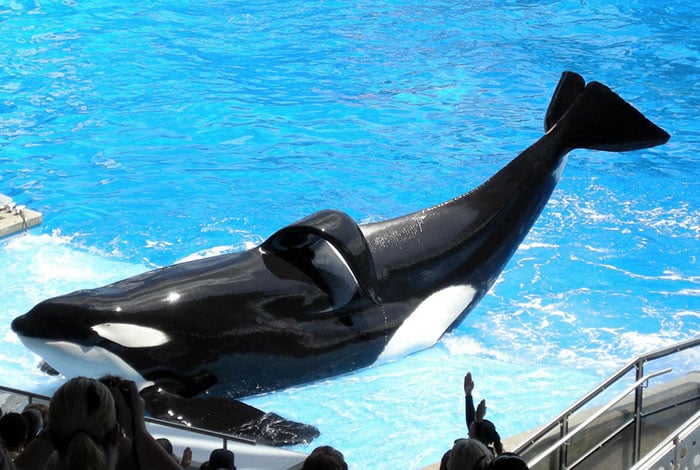 "Shamu" (Tilikum) | Milan Boers | CC by 2.0
"Shamu" (Tilikum) | Milan Boers | CC by 2.0
Tilikum had a collapsed dorsal fin. Many orcas in captivity (but few in nature) have collapsed fins.
- A 2017 study published in Archives of Oral Biology documented that there was significant damage to and drilling of the teeth of orcas held captive by SeaWorld—their teeth are flushed daily without painkillers, which is likely excruciating.
- A dolphin named Ringer was impregnated by her own father while on SeaWorld’s watch. (She had several babies—all of them have died.)
- In 2011, 10 baby penguins were taken away from their parents in Antarctica and shipped to SeaWorld for “research purposes.”
- Orca Takara was forcibly impregnated many times at SeaWorld. She was just starting to build a relationship with her daughter Kyara in 2017 when the infant died at only 3 months old.
- SeaWorld separated Takara from her mother, Kasatka, after they’d lived together harmoniously for 12 years.
- Tilikum was the biological father of more than half the orcas who’ve been born at SeaWorld, and more than half of his offspring have already died prematurely.
- Tilikum died, too, after 33 miserable years in captivity.
- Orca Ikaika, who was born at SeaWorld Orlando, was torn from his mother when he was 4 years old and shipped to Marineland in Ontario, Canada.
- SeaWorld separated orca Katerina from her mother, Katina (who was captured in nature and separated from her pod), after two years.
- SeaWorld separated orca Sumar and his mother, Taima, after she attacked him during a live show at SeaWorld Orlando. Sumar was just 6 months old at the time.
- After being bred repeatedly by SeaWorld, orca Taima (who had given birth to numerous calves) died from complications that arose during the delivery of a stillborn male calf.
- Orca Trua and his mother, Takara, were separated after three years together—Trua remained at SeaWorld Orlando while Takara was shipped to SeaWorld San Antonio.
- Orca Kalina was separated from her mother when she was 4 years old, and in the span of only 16 months, she was hauled across the country three times to different SeaWorld parks.
- Before separating orca Taku from his mother, Katina, SeaWorld allowed them to breed with each other—meaning that Taku’s daughter, Nalani, was also his sister.
- When orca Kohana (who, while with SeaWorld, was bred twice with her uncle and rejected both calves) was 3 years old, she was separated from her mother, Takara. The two are now kept on different continents.
- Orca Kalina (who is now dead) often helped other captive orcas raise their babies, perhaps because her own calves were torn away from her and shipped around the world.
- Unna, another orca, died at SeaWorld San Antonio after being transferred from SeaWorld Orlando, where her family resides. She died at just 18 years old of an infection that’s common in orcas in captivity but unheard of in nature. In their natural habitats, female orcas can live to be more than 80 years old.
- In 2018, orca Katina’s dorsal fin was split open—a potentially life-threatening injury—during an interaction with incompatible members of her contrived “pod” at SeaWorld Orlando.
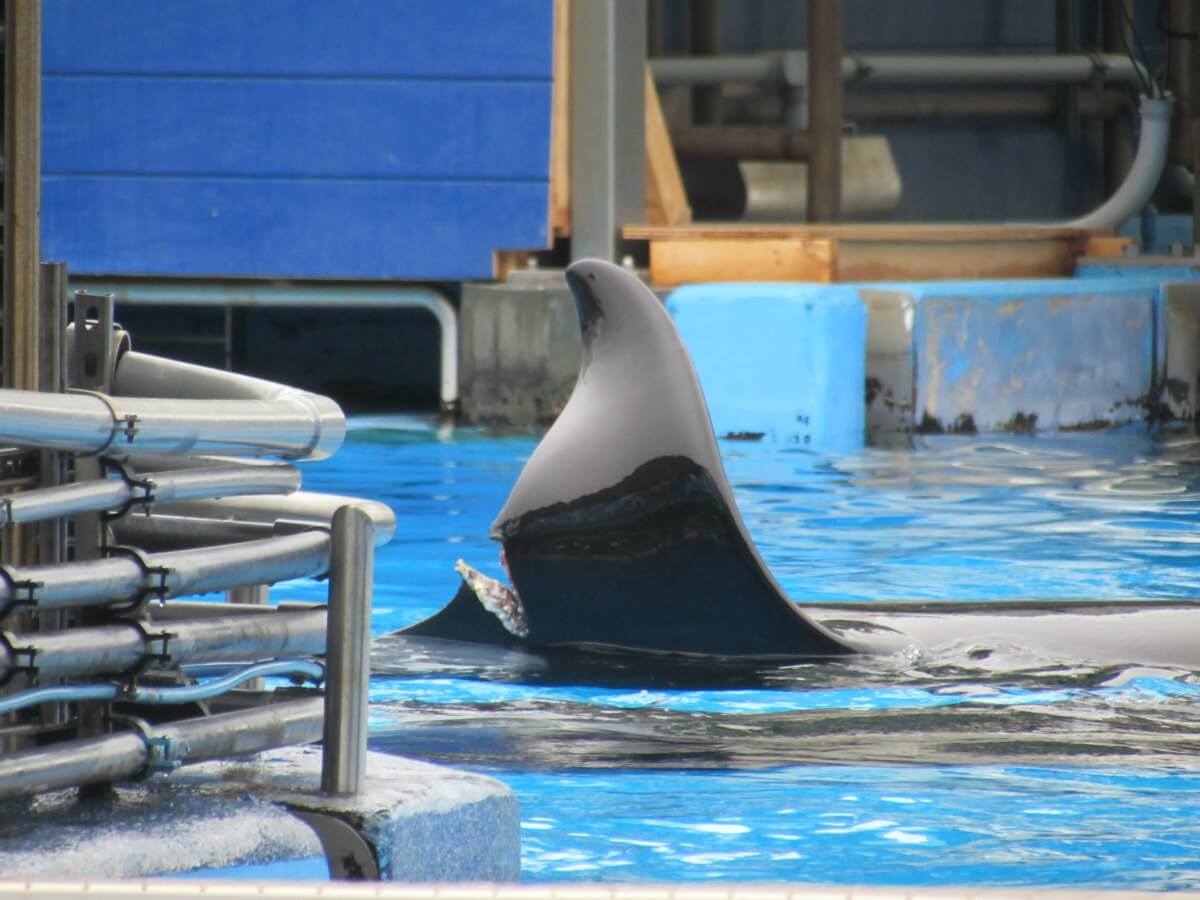
- Orca Keet—who’d been separated by SeaWorld from his mother, Kalina, at just 1 year old—was relocated repeatedly to various SeaWorld parks around the U.S.
- An orca named Tuar was taken from his mother, also Kalina, at SeaWorld Orlando when he was 4 years old and shipped to SeaWorld San Antonio.
- SeaWorld still offers touch tanks and other animal “encounters,” falsely teaching kids that it’s OK to handle wild animals against their will.
- According to a scathing November 19 article from The Travel, SeaWorld forces every employee to participate in its conspiracy to conceal its cruelty from the public.
Despite this litany of tragedies and changing public attitudes, SeaWorld has refused hundreds of thousands of calls from PETA members and supporters to modernize its parks, stop using animals, and move those held in tanks to sanctuaries.
Of the 13 members of Corky’s pod who were captured in 1968 and 1969, she is the only one left alive. It’s too late for Tilikum, Szenja, Sharky, and so many more, but SeaWorld can still do right by Corky by allowing her to spend her senior years in a seaside sanctuary.
Corky could feel flowing currents, dive deep into the water, and possibly even communicate with her brother and sister (Fife and Ripple) who still visit Blackfish Sound. But for that to happen, SeaWorld must act—now.
It’s up to us to urge SeaWorld to do the right thing. Click below to ask the marine park company to implement a firm and rapid plan to retire Corky to a seaside sanctuary where she’ll be given a semblance of the natural life that she has been denied for so long:

